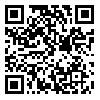Volume 11, Issue 3 (Pajouhan Scientific Journal, Spring 2013)
Pajouhan Sci J 2013, 11(3): 9-15 |
Back to browse issues page
Download citation:
BibTeX | RIS | EndNote | Medlars | ProCite | Reference Manager | RefWorks
Send citation to:



BibTeX | RIS | EndNote | Medlars | ProCite | Reference Manager | RefWorks
Send citation to:
Farhoudian A, Soleimaninia L, Gharib M, Farhadi M H, Sadeghi M. Survey of special needs in physically disabled people: A qualitative study. Pajouhan Sci J 2013; 11 (3) :9-15
URL: http://psj.umsha.ac.ir/article-1-60-en.html
URL: http://psj.umsha.ac.ir/article-1-60-en.html
1- , gharib_masoud@yahoo.com
Abstract: (10721 Views)
Introduction: after sanction of «the rights of disabled people convention» United Nations Organization have been stressed more on dealing with this group's needs.
Therewith, most of countries in the world have been committed in this field. Therefore, with consideration of importance of identifying the needs in disabled people and making policies for them, this study conducted in order to identify the special needs in physically disabled people.
Methods: this study is a part of a qualitative research with grounded theory method. Fifteen physically disabled people were selected through a purposeful sampling participated in study. The main method for collecting data was semi-structured interview that continued until theoretical saturation of information. Data was analyzed with Strauss & Corbin coding manner or continued comparison and the assessor's viewpoints method is used for validity promotion of data.
Results: Totally, most important domains of special needs in disabled group were: family and relatives, education, movement and transportation, building and places (houses and public places), social participation and occupation, treatment and rehabilitation services, and people's attitude toward their problems.
Conclusion: the results indicated that for promoting social participation and function independency in disabled people, should be emphasis on «equality of opportunities» in society rather than «disability». Thus, public systems and services should be available equally for all, such as physical environments and places, housing, transport system, educational and vocational opportunities, and socio-cultural life like equipments for sport and amusement. Then, physically disabled people can reach to a life with more quality and same with others.
Methods: this study is a part of a qualitative research with grounded theory method. Fifteen physically disabled people were selected through a purposeful sampling participated in study. The main method for collecting data was semi-structured interview that continued until theoretical saturation of information. Data was analyzed with Strauss & Corbin coding manner or continued comparison and the assessor's viewpoints method is used for validity promotion of data.
Results: Totally, most important domains of special needs in disabled group were: family and relatives, education, movement and transportation, building and places (houses and public places), social participation and occupation, treatment and rehabilitation services, and people's attitude toward their problems.
Conclusion: the results indicated that for promoting social participation and function independency in disabled people, should be emphasis on «equality of opportunities» in society rather than «disability». Thus, public systems and services should be available equally for all, such as physical environments and places, housing, transport system, educational and vocational opportunities, and socio-cultural life like equipments for sport and amusement. Then, physically disabled people can reach to a life with more quality and same with others.
Type of Study: Research Article |
Received: 2014/09/12 | Accepted: 2014/09/12 | Published: 2014/09/12
Received: 2014/09/12 | Accepted: 2014/09/12 | Published: 2014/09/12
Send email to the article author
| Rights and permissions | |
 |
This work is licensed under a Creative Commons Attribution-NonCommercial 4.0 International License. |





